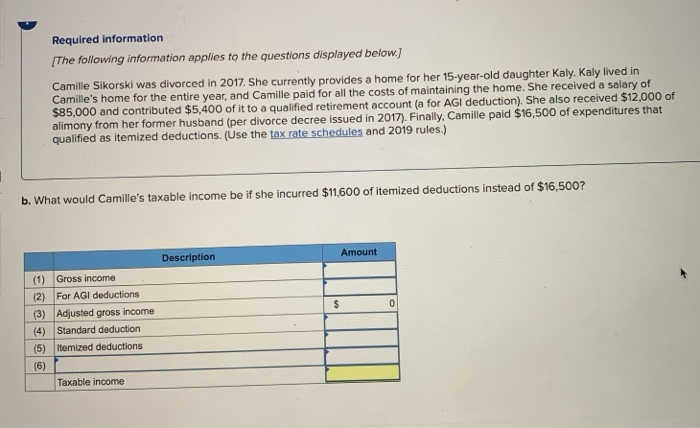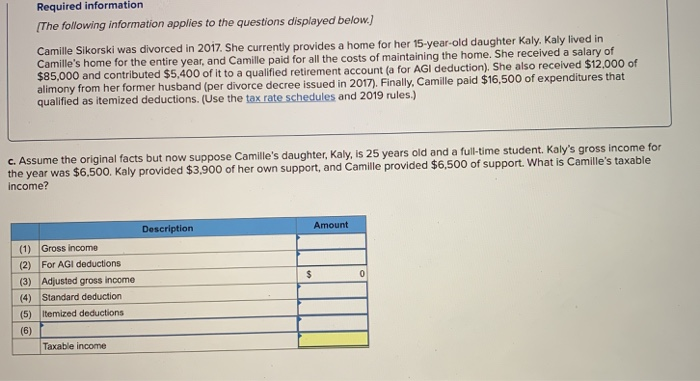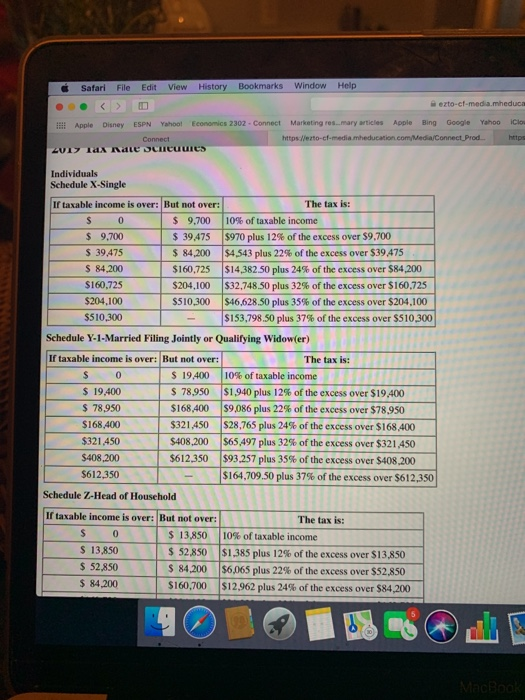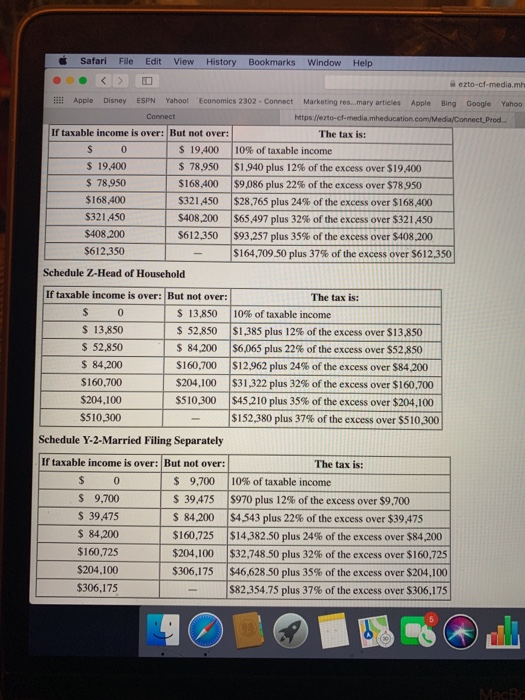[The following information applies to the questions displayed below) Camille Sikorski was divorced in 2017. She currently provides a home for her 15-year-old daughter Kaly. Kaly lived in Camille's home for the entire year, and Camille paid for all the costs of maintaining the home. She received a salary of $85,000 and contributed $5,400 of it to a qualified retirement account (a for AGI deduction). She also received $12,000 of alimony from her former husband (per divorce decree issued in 2017). Finally, Camille paid $16,500 of expenditures that qualified as itemized deductions. (Use the tax rate schedules and 2019 rules.) a. What is Camille's taxable income? Answer is complete but not entirely correct. $ (1) (2) (3) Amount 97,000 5,400 91,600 18,000 16,500 Description Gross income For AGI deductions Adjusted gross income Standard deduction Itemized deductions Greater of standard deductions or itemized deductions Taxable income $ (5) (6) $ 18.000 73,600 $ Required information [The following information applies to the questions displayed below.) Camille Sikorski was divorced in 2017. She currently provides a home for her 15-year-old daughter Kaly. Kaly lived in Camille's home for the entire year, and Camille paid for all the costs of maintaining the home. She received a salary of $85,000 and contributed $5,400 of it to a qualified retirement account (a for AGI deduction). She also received $12,000 of alimony from her former husband (per divorce decree issued in 2017). Finally, Camille paid $16,500 of expenditures that qualified as itemized deductions. (Use the tax rate schedules and 2019 rules.) b. What would Camille's taxable income be if she incurred $11,600 of itemized deductions instead of $16,500? Amount Description $ 0 (1) Gross income (2) For AGI deductions (3) Adjusted gross income (4) Standard deduction (5) Itemized deductions (6) Taxable income Required information [The following information applies to the questions displayed below.) Camille Sikorski was divorced in 2017. She currently provides a home for her 15-year-old daughter Kaly. Kaly lived in Camille's home for the entire year, and Camille paid for all the costs of maintaining the home. She received a salary of $85,000 and contributed $5,400 of it to a qualified retirement account (a for AGI deduction). She also received $12,000 of alimony from her former husband (per divorce decree issued in 2017). Finally, Camille paid $16,500 of expenditures that qualified as itemized deductions. (Use the tax rate schedules and 2019 rules.) c. Assume the original facts but now suppose Camille's daughter, Kaly, is 25 years old and a full-time student. Kaly's gross income for the year was $6.500. Kaly provided $3,900 of her own support, and Camille provided $6,500 of support. What is Camille's taxable income? Description Amount $ 0 (1) Gross income (2) For AGI deductions (3) Adjusted gross income (4) Standard deduction (5) temized deductions (6) Taxable income Safari File Edit View History Bookmarks Window Help ezto-ct-media.meduca iClo Apple Disney ESPN Yahoo! Economics 2302 - Connect Marketing res...mary articles Apple Bing Google Yahoo Connect https://exto-cf-media meducation.com/Media/Connect Prod 201Y TUNIC CHICULES https Individuals Schedule X-Single If taxable income is over: But not over: The tax is: $ 0 $ 9,700 10% of taxable income $ 9,700 $ 39,475 $970 plus 12% of the excess over $9,700 $ 39,475 $ 84,200 $4,543 plus 22% of the excess over $39475 $ 84,200 $160,725 $14,382.50 plus 24% of the excess over $84,200 $160,725 $204,100 $32,748.50 plus 32% of the excess over $160,725 $204,100 $510,300 $46.628.50 plus 35% of the excess over $204,100 $510,300 $153,798.50 plus 37% of the excess over $510,300 Schedule Y-1-Married Filing Jointly or Qualifying Widow(er) If taxable income is over: But not over: The tax is: $ 0 $ 19,400 10% of taxable income $ 19,400 $ 78,950 $1.940 plus 12% of the excess over $19.400 $ 78,950 $168.400 $9,086 plus 22% of the excess over $78,950 $168,400 $321.450 $28,765 plus 24% of the excess over $168.400 $321,450 $408,200 $65,497 plus 32% of the excess over $321,450 $408,200 $612,350 $93.257 plus 35% of the excess over $408.200 $612,350 $164,709.50 plus 37% of the excess over $612,350 Schedule Z-Head of Household If taxable income is over: But not over: $ 0 $ 13,850 $ 13,850 $ 52,850 $ 52,850 $ 84.200 $ 84,200 $160,700 The tax is: 10% of taxable income $1,385 plus 12% of the excess over $13,850 $6,065 plus 22% of the excess over $52,850 $12,962 plus 24% of the excess over $84,200 MacBook Safari File Edit View History Bookmarks Window Help ezto-cf-media.mh !! Apple Disney ESPN Yahool Economics 2302 - Connect Marketing ros...mary articles Apple Bing Google Yahoo Connect https://ezto-cf-media.meducation.com/Media/Connect_Prod. If taxable income is over: But not over: The tax is: $ 0 $ 19.400 10% of taxable income $ 19,400 $ 78,950 $1.940 plus 12% of the excess over $19.400 $ 78,950 $168.400 $9.086 plus 22% of the excess over $78,950 $168.400 $321.450 $28,765 plus 24% of the excess over $168,400 $321.450 $408.200 $65,497 plus 32% of the excess over $321.450 $408.200 S612,350 $93,257 plus 35% of the excess over $408,200 $612,350 $164,709.50 plus 37% of the excess over $612,350 Schedule Z-Head of Household If taxable income is over: But not over: The tax is: $ 0 $ 13,850 10% of taxable income $ 13,850 $ 52.850 $1,385 plus 12% of the excess over $13,850 $ 52,850 $ 84,200 $6,065 plus 22% of the excess over $52,850 $ 84,200 $160,700 $12,962 plus 24% of the excess over $84,200 $160,700 $204,100 $31,322 plus 32% of the excess over $160,700 $204,100 $510,300 $45,210 plus 35% of the excess over $204,100 $510,300 $152,380 plus 37% of the excess over $510,300 Schedule Y-2-Married Filing Separately If taxable income is over: But not over: The tax is: $ 0 $ 9,700 10% of taxable income $ 9,700 $ 39,475 $970 plus 12% of the excess over $9,700 $ 39,475 $ 84,200 $4,543 plus 22% of the excess over $39,475 $ 84,200 $160,725 $14,382.50 plus 24% of the excess over $84,200 $160,725 $204,100 $32,748.50 plus 32% of the excess over $160,725 $204.100 $306,175 $46,628 50 plus 35% of the excess over $204,100 $306,175 $82,354.75 plus 37% of the excess over $306,175 MacBo











